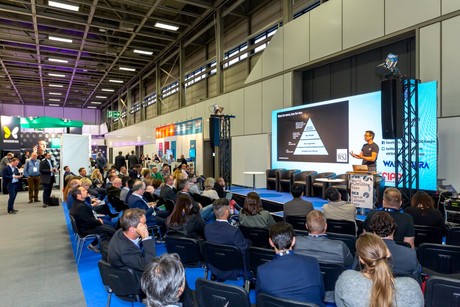But what about peaceful coexistence as a third way? Several newspapers across the country have conducted surveys recently that found, at least on Sunday when they’re more relaxed, that people enjoy the physical experience of holding something in their hands while perusing different sections of the paper for items of interest to which they can devote a deeper read. Oh, and the coupons, too. Who wants to have to print out yet another thing from your phone or laptop? Spurred by this enlightenment, many publishers have conducted highly successful marketing campaigns around these themes.
To be sure, everyone is busier than ever today. Most weekdays, people skim alerts on their phones while on the move, or steal a few minutes away from their computers at work to read a breaking story online. Fans of digital news argue, rightly, that they are better informed because of those capabilities and are able to keep up with world events in real time, rather than when they get home at the end of the day.
On the other hand, there are certain neurological, psychological and intellectual implications to over-reliance on digital content. For example, eye doctors worry about Digital Eye Strain resulting from too much time spent glaring at computer screens and digital devices.
Yet whether it’s long-term retinal damage or merely sleep loss caused by the so-called “blue light effect,” we’re certainly not going to -- nor should we -- eliminate these unavoidably vital devices from our lives. We can, however, mitigate their effects. Consider how far print quality has come recently, and the role newspapers still play in the evolving information age.
By integrating online “content consumption” with readership of traditional print materials that are now produced faster, and with a greater level of tactile clarity, vibrancy, and timely relevance than ever before, we can also benefit from what studies show to be improvement in retention and focus on the information we read and act upon as responsible citizens.
Whether it’s emerging economies, where literacy and civic engagement are happily on the rise, or in more mature newspaper markets, the importance of advancements in user-friendly print systems, such as Kodak’s NEXPRESS platform, process free plates and CTP thermal imaging technology, cannot be overstated. These new technologies are helping to reduce the amount of chemistry, energy, water and waste used to produce printed content, keeping the printing industry profitable and sustainable. They are also providing printers with new ways to differentiate printed products, with offerings such as new metallic inks, dimensional inks, and capabilities to print on a wider variety of substrates. This ultimately enhances the reading experience through an expansion of texture, color palette and endless possibilities of what can be printed on today.
According to accounting and consulting giant PwC’s survey, “Global Entertainment and Media Outlook 2016-2020,” newspaper print unit circulation, globally, is actually rising despite drop-offs in the west. Those gains are being strongly fueled by the popularity of newspapers among the “aspirational classes” in parts of Asia-Pacific and Latin America. As PwC’s report goes on to say, “the fact that circulation is growing in emerging markets opens up clear opportunities for future growth in spending in those markets as audiences reach critical levels.”
But let’s look for a moment beyond financial opportunities and focus on the “reading experience” of our end-users – those folks who enjoy spreading out their Sunday papers on the kitchen table. A recent European study reported on by The Guardian measured the information retention of subjects after reading both a hardcopy and electronic copy of a short story. The research concluded that tablet readers performed ‘significantly’ worse than paperback readers when asked to reconstruct the story’s plot.
One of the primary drivers behind that result, the study found, could have to do with the concept of ‘deep reading’ as enabled by print. Deep reading refers to a level of engagement when a reader is fully attentive to a text. It requires full attention, in contrast with how people read content on the Internet: by quickly skimming and scrolling as their eyes dart away from relevant, key facts and over to the deliberate distractions of click bait.
The superficiality and focus deficit that’s crept into our reading experience has a variety of implications for the emerging economies we mentioned. In particular, and as everywhere in the world, readers who only skim quickly through their digital news feeds are more susceptible to the kind of politically-driven, psychological manipulation that we’re just beginning to learn about in connection with the most widely used social media platforms.
That returns us to the concept of “deep reading,” which Robert P. Waxler and Maureen P. Hall in their book, “Transforming Literacy: Changing Lives Through Reading and Writing,” said “requires human beings to call upon and develop attention skills, to be thoughtful and fully aware.” If there’s one thing that serious-minded people need, it is to be thoughtful and keenly aware of where their news comes from.
But don’t think the newspapers we publish place the level of intellectual demand on readers that may send them fleeing back to their devices. To the contrary. A recent study by the Canadian neuro-marketing firm TrueImpact compared the effects of paper marketing against those of digital media. The findings? “Print marketing materials require 21 percent less cognitive effort to process than digital media.” And, in a supporting test run in the study that is sure to make our advertising customers take notice, brand recall from printed materials was 70 percent higher with printed materials.
So, next time you sit down and read a newspaper off today’s modern, high-tech printing presses, think of the rewards it brings to your precious eyes, your discerning intellect, and your civic spirit.
(http://www.kodak.com)
Strict News Diet of ‘Skim & Scroll’ Fails to Satisfy at Kitchen Table or in Emerging Economies
Strict News Diet of ‘Skim & Scroll’ Fails to Satisfy at Kitchen Table or in Emerging Economies
Article ID:
21436
From Rich Rindo, General Manager, Offset Print and Vice President, Print Systems Division, at Kodak
16.11.2017 – Too many debates nowadays are of the divisive and irreconcilable “either/or” variety – the kind that offer false choices that never fully satisfy and only sow further division. The same can be said about the commonly held assumptions about print vs. digital news consumption. Either we get all our news digitally…instantly, but often of dubious origin, verity and depth…or, we read it in print, with some natural lag time and the “muscle strain” of having to turn pages.

Rich Rindo.
Attachments
Related Articles
-
2020-10-15 11:21
-
2020-10-08 10:36
-
2020-09-29 17:42
-
2020-09-29 17:24
-
2020-09-29 10:57




